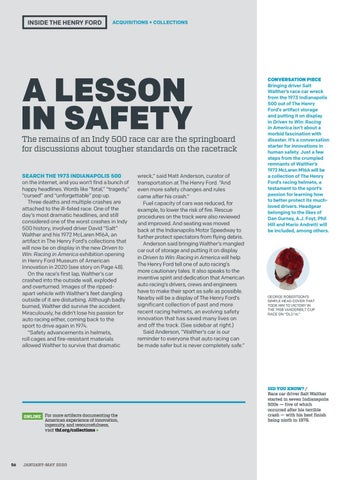INSIDE THE HENRY FORD
ACQUISITIONS + COLLECTIONS
A LESSON IN SAFETY
The remains of an Indy 500 race car are the springboard for discussions about tougher standards on the racetrack SEARCH THE 1973 INDIANAPOLIS 500 on the internet, and you won’t find a bunch of happy headlines. Words like “fatal,” “tragedy,” “cursed” and “unforgettable” pop up. Three deaths and multiple crashes are attached to the ill-fated race. One of the day’s most dramatic headlines, and still considered one of the worst crashes in Indy 500 history, involved driver David “Salt” Walther and his 1972 McLaren M16A, an artifact in The Henry Ford’s collections that will now be on display in the new Driven to Win: Racing in America exhibition opening in Henry Ford Museum of American Innovation in 2020 (see story on Page 48). On the race’s first lap, Walther’s car crashed into the outside wall, exploded and overturned. Images of the rippedapart vehicle with Walther’s feet dangling outside of it are disturbing. Although badly burned, Walther did survive the accident. Miraculously, he didn’t lose his passion for auto racing either, coming back to the sport to drive again in 1974. “Safety advancements in helmets, roll cages and fire-resistant materials allowed Walther to survive that dramatic
ONLINE For more artifacts documenting the American experience of innovation, ingenuity, and resourcefulness, visit thf.org/collectionsc
56
JANUARY-MAY 2020
wreck,” said Matt Anderson, curator of transportation at The Henry Ford. “And even more safety changes and rules came after his crash.” Fuel capacity of cars was reduced, for example, to lower the risk of fire. Rescue procedures on the track were also reviewed and improved. And seating was moved back at the Indianapolis Motor Speedway to further protect spectators from flying debris. Anderson said bringing Walther’s mangled car out of storage and putting it on display in Driven to Win: Racing in America will help The Henry Ford tell one of auto racing’s more cautionary tales. It also speaks to the inventive spirit and dedication that American auto racing’s drivers, crews and engineers have to make their sport as safe as possible. Nearby will be a display of The Henry Ford’s significant collection of past and more recent racing helmets, an evolving safety innovation that has saved many lives on and off the track. (See sidebar at right.) Said Anderson, “Walther’s car is our reminder to everyone that auto racing can be made safer but is never completely safe.”
CONVERSATION PIECE Bringing driver Salt Walther’s race car wreck from the 1973 Indianapolis 500 out of The Henry Ford’s artifact storage and putting it on display in Driven to Win: Racing in America isn’t about a morbid fascination with disaster. It’s a conversation starter for innovations in human safety. Just a few steps from the crumpled remnants of Walther’s 1972 McLaren M16A will be a collection of The Henry Ford’s racing helmets, a testament to the sport’s passion for learning how to better protect its muchloved drivers. Headgear belonging to the likes of Dan Gurney, A.J. Foyt, Phil Hill and Mario Andretti will be included, among others.
GEORGE ROBERTSON’S SIMPLE HEAD COVER THAT TOOK HIM TO VICTORY IN THE 1908 VANDERBILT CUP RACE ON “OLD 16.”
DID YOU KNOW? / Race car driver Salt Walther started in seven Indianapolis 500s — five of which occurred after his terrible crash — with his best finish being ninth in 1976.
